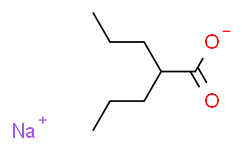基本信息
|
产品编号:V70002 |
|||||
|
产品名称:Valproic acid sodium salt |
|||||
|
CAS: |
1069-66-5 |
储存条件 |
粉末 |
室温 |
四年 |
|
|
|
||||
|
分子式: |
溶于液体 |
-80℃ |
两年 |
||
|
分子量 |
166.10 |
-20℃ |
一个月 |
||
|
化学名: |
|||||
|
Solubility (25°C) |
体外 |
DMSO |
33mg/mL (198.56mM) |
||
|
Ethanol |
33mg/mL (198.56mM) |
||||
|
Water |
33mg/mL (198.56mM) |
||||
|
体内 |
现配现用 |
|
|||
|
<1mg/ml表示微溶或不溶。 |
|||||
|
普西唐提供的所有化合物浓度为内部测试所得,实际溶液度可能与公布值有所偏差,属于正常的批间细微差异现象。 |
|||||
|
请根据产品在不同溶剂中的溶解度选择合适的溶剂配制储备液;⼀旦配成溶液,请分装保存,避免反复冻融造成的产品失效。 |
|||||
制备储备液
|
浓度
溶液体积 质量 |
1mg |
5mg |
10mg |
|
1mM |
6.0172mL |
30.0860mL |
60.1721mL |
|
5mM |
1.2034mL |
6.0172mL |
12.0344mL |
|
10mM |
0.6017mL |
3.0086mL |
6.0172mL |
|
50mM |
0.1203mL |
0.6017mL |
1.2034mL |
生物活性
|
产品描述 |
一种HDAC 的抑制剂,能够选择性的诱导 HDAC2 的白酶体降解。 |
||
|
靶点/IC50 |
HDAC |
Autophagy |
GABA receptor |
|
体外研究 |
Valproic acid通过不同的途径直接抑制组蛋白脱乙酰基酶,抑制HDAC1的IC50为0.4mM。在培养的细胞中,Valproic acid类似组蛋白去乙酰化酶抑制剂Trichostatin A,引起组蛋白的去乙酰化。Valproic acid,如Trichostatin A,也激活不同的外源性和内源性启动子的转录。在脊椎动物的胚胎中,Valproic acid和Trichostatin A具有非常相似的致畸作用,而不激活转录。 Valproic acid诱导啮齿动物肝脏过氧化物酶体增殖。在表达PPARδ的配体结合结构域和糖皮质激素受体(GR)的DNA结合域,以及GR控制的报告基因融合的细胞中,Valproic acid在 1mM的浓度释放N-COR,TR或PPARδ融合的Gal4的抑制。Valproic acid诱导少乙酰化组蛋白的积累并抑制HDAC活性。Valproic acid诱导一种特定类型的分化,标志是减少的增殖,形态改变,标志物基因的表达和AP-2的转录因子的累积,AP-2是神经元或神经嵴细胞样分化的F9畸胎瘤细胞的潜在标记物。在F9和P19畸胎瘤细胞中,Valproic acid损害细胞增殖或存活,表现为[3H]胸苷渗入减少。 |
||
|
体内研究 |
Valproic acid延迟了MT-450大鼠乳腺癌模型中原发肿瘤的生长。 |
||
推荐实验方法(仅供参考)
|
激酶实验: |
|
|
Kinase Assay |
The activity of caspase-3, -8 and -9 is assessed using the caspase-3, -8 and -9 colorimetric assay kits, respectively. In brief,1×106 cells in a 60-mm culture dish are incubated with 10mM Valproic acid for 24 h. The cells are then washed in PBS and suspended in 5 volumes of lysis buffer provided with the kit. Protein concentrations are determined using the Bradford method. Supernatants containing 50μg total protein are used to determine caspase-3, -8 and -9 activities. The supernatants are added to each well in 96-well microtiter plates with DEVD-pNA, IETD-pNA or LEHD-pNA as caspase-3, -8 and -9 substrates and the plates are incubated at 37°C for 1 h. The optical density of each well is measured at 405nm using a microplate reader. The activity of caspase-3, -8 and -9 is expressed in arbitrary absorbance units |
|
细胞实验: |
|
|
Cell Assay |
In brief, 5×105 cells are seeded in 96-well microtiter plates for MTT assays. After exposure to the designated doses of Valproic acid for the indicated times, MTT solution [20mL: 2mg/mL in phosphate-buffered saline (PBS)] is added to each well of the 96-well plates. The plates are additionally incubated for 3 h at 37°C. Medium is withdrawn from the plates by pipetting and 200mL DMSO is added to each well to solubilize the formazan crystals. The optical density is measured at 570nm using a microplate reader. |
|
动物实验: |
|
|
Animal Administration |
Splenectomies are performed on the BALB/c nude mice. One week after the splenectomies, the mice receiv whole body irradiation with 137Cs at a dose of 4 Gy. At 48-72 h post-irradiation, the mice are subcutaneously implanted with Kasumi-1 cells (2×107 cells/mouse with 0.15-0.2mL) in the right axillary region. The mice are randomLy assigned to two groups, the Valproic acid (n=6) and control (n=6) groups. When the tumors are appr 200 mm3 in size at appr 10 days post-implantation, 0.2mL Valproic acid (500 mg/kg body weight) or 0.2mL saline is injected intraperitoneally every day. Valproic acid is dissolved in saline at a concentration of 25mg/mL. The longest diameter (a) and the shortest diameter (b) of the tumor are measured every three days, and the tumor volume (TV) is calculated according to the following formula: TV=1/2×a×b2.Following two weeks of injections, the mice are sacrificed by cervical dislocation and the tumor masses are removed for the following experiments. |
本计算器可帮助您计算出特定溶液中溶质的质量、溶液浓度和体积之间的关系,公式为:
质量 (g) = 浓度 (mol/L) x 体积 (L) x 分子量 (g/mol)
摩尔浓度计算公式
用本工具协助配置特定浓度的溶液,使用的计算公式为:
开始浓度 x 开始体积 = 最终浓度 x 最终体积
稀释公式
稀释公式一般简略地表示为:C1V1 = C2V2 ( 输入 输出 )









